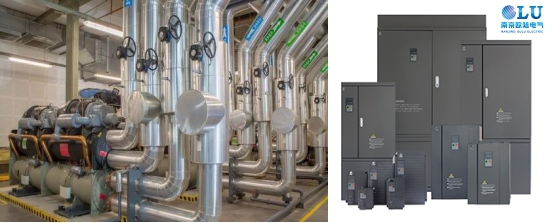The Role of Nanjing Euroverter Frequency Converters in Energy Savings for Central Air Conditioning Water Pumps
With the continuous improvement of living standards in China, central air conditioning systems have been widely implemented across various sectors including hotels, restaurants, industrial facilities, and office buildings.
The design of central air conditioning systems is primarily based on outdoor meteorological parameters and indoor design requirements to calculate cooling loads. Equipment is then selected from product catalogs according to zonal structural characteristics and combined into a complete system. However, these systems operate under partial load conditions for the majority of their runtime, resulting in significant energy waste.
With advancements in modern technology, Nanjing Euroverter frequency converters have been extensively applied in energy-saving retrofits for central air conditioning water pumps. By adopting variable frequency drive (VFD) control technology in central air conditioning systems, average energy savings exceeding 20% can be achieved at relatively low cost.

Application Case of Nanjing Euroverter Frequency Converters in Central Air Conditioning Pump Energy Savings
With the adoption of variable frequency control, energy transfer and distribution are regulated through variable water volume (VWV) and variable air volume (VAV), achieving optimal temperature differential displacement. The power consumption is only 30–60% of conventional control systems, with dual energy-saving effects—reducing both pump energy use and chiller demand.
For chillers, frequency conversion maintains designed refrigerant parameters (temperature difference, pressure, etc.), delivering superior energy savings compared to other load-adjustment methods. For example, York's YT centrifugal chillers with VFDs can achieve a part-load efficiency as low as 0.2 kW/ton, demonstrating the vast potential of VFDs in HVAC systems.
Overcoming Cost Barriers
Historically, VFD adoption in central air conditioning was limited by cost. Today, with mature VFD and automation technologies, integrating them with HVAC systems is economically viable—even for small systems—and essential for large central systems due to:
Extended runtime: Higher cumulative energy savings.
Low cost proportion: VFDs account for a minor fraction of total system costs.
Economies of scale: Larger VFDs offer lower cost per kW.
The payback period typically ranges 6–12 months, with 10-year net returns exceeding 10× the initial investment.
Energy-Saving Principles of VFDs in Central AC
Traditional Systems:
High inrush currents (mechanical/electrical stress).
Inefficient temperature regulation (constant full-load operation).
Energy waste in partial-load conditions.
Use star-delta starters for fixed-speed operation, causing:
VFD Retrofit Benefits:
Lower operating stress extends pump/motor寿命.
Eliminates water hammer and grid冲击 (current stays <100% rated).
Closed-loop ΔT control: Auto-adjusts flow to match indoor/outdoor thermal loads.
Constant ΔT control: Adjusts pump speed based on chiller return/supply water ΔT, preventing lithium bromide crystallization in absorption chillers.
Energy savings: Proportional to flow reduction (power ∝ speed³).
Cooling Tower Pumps:
Chilled Water Pumps:
Soft Start/Stop:
Reduced Maintenance:
Retrofit Design & Implementation
1. Cooling Water Pump System
Control Strategy: Constant ΔT (between condenser supply/return).
Sensors: High-accuracy temperature transmitters.
Energy Savings: ≥20%.
Protections: Over-ΔT, low-pressure alarms, and pump overload alerts.
2. Chilled Water Pump System
Cooling Mode:
Frequency adjustment based on return water temperature (↑T → ↑speed).
Minimum frequency lock to ensure flow demand.
Heating Mode:
Inversely correlates speed with return water T (↓T → ↑speed).
System Components
VFDs (EV Series): Enhance motor PF and efficiency.
Sensors: Precision temperature/pressure monitoring.
Control Panel: Centralized HVAC-dedicated PLC for remote operation.
Low-Voltage Components: Reliable circuit protection (breakers, contactors).
Proven Applications
Nanjing Euroverter’s solutions are deployed in 100+ projects across:
Jiangsu (Nanjing, Suzhou, Wuxi, Changzhou, Zhenjiang).
Zhejiang (Hangzhou).
Other regions: Henan, Hebei, Jiangxi, Hunan, Shandong.
Key Outcomes:
20%+ energy reduction.
Extended equipment lifespan (pipes, valves, bearings).
Stable ROI (<1 year).
For customized energy-saving plans, contact Nanjing Euroverter’s technical team.